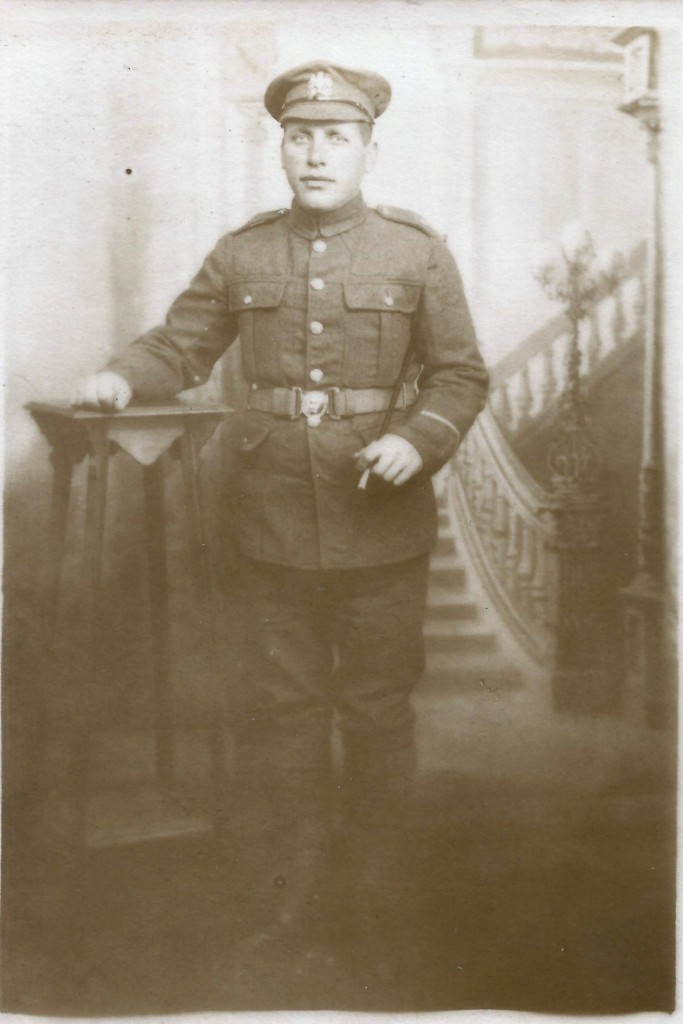This guide to ww1 wound stripes will explain what they were and why they were awarded and how to find them in photographs. Also, how they can help you research a soldier’s service by looking for them in a casualty list. This article is one of a series I have written to help you research British Army soldiers who served during the war:
What was a WW1 Wound Stripe?
The award of a stripe to soldiers who had been wounded during the war was authorized by Army Order 249 of 6 July 1916. This order allowed those who had appeared in a War Office casualty list to sew a two-inch stripe of gold Russia braid onto the left sleeve of their service jacket. However, soldiers soon found that Russia braid quickly tarnished and was difficult to clean. In view of these difficulties, a number of companies produced brass versions, which could be quickly detached from the uniform and polished. The extract from the photograph above shows a wound stripe on the sleeve of a soldier of the Royal Field Artillery.
Part of the original Army Order is shown below, along with some amendments which appeared in later Army Council Instructions. A soldier would be able to add an additional wound stripe for each subsequent appearance in the casualty list. An accidental injury did not count, nor did self-inflicted wounds.
Army Order 204 of 6 July 1916
The following distinctions in dress will be worn on the service dress jacket by all officers and soldiers who have been wounded in any of the campaigns since 4 August, 1914.
Strips of gold Russia braid, No.1, two inches in length, sewn perpendicularly on the left sleeve of the jacket to mark each occasion on which wounded. In the case of officers, the lower end of the first strip of gold braid will be immediately above the upper point of the flap on cuff. Warrant officers, non-commissioned officers and men will wear the gold braid on the left sleeve, the lower edge of the braid to be three inches from the bottom of the sleeve.
Army Council Instruction 1637 of 22 August 1916
… the term ‘wounded’ refers only to those officers and soldiers whose names have appeared, or may hereafter appear, in the Casualty Lists as ‘wounded’.
Army Council Instruction 2075 of 3 November 1916
Officers and men reported “wounded – gas,” or “wounded – shock, shell,” are entitled to the distinction. Accidental or self-inflicted wounds or injuries do not qualify.”
Due to the material they were made from, ww1 wound stripes are often easy to spot in photographs but not all are. A wound stripe will always appear on the lower left-hand sleeve of a soldier’s service jacket and was two inches (5 cm) in length. Look on a man’s left sleeve for a thin line, around the size of a little finger. You may need to use a magnifying glass depending on the photograph. Below you can see a soldier with a barely visible wound stripe below his good conduct chevron on his left sleeve. He wears the general service cap badge, worn by soldiers in the Labour Corps. It is possible that the wound that led to the stripe caused him to be transferred to the Labour Corps as he was no longer fit for front line service. We will never know for certain as there is no name on the photograph.
How a WW1 Wound Stripe can help you Research a Soldier
Providing you know the name of the soldier in question, a wound stripe can be very useful when researching them. This is especially so if no service record has survived or it doesn’t record the date/s a soldier was wounded. Any photograph with a wound stripe appearing must date from post-July 1916 and very likely prior to December 1922 when an Army Order announced they were to be no longer worn on uniforms. Also, a soldier’s name should appear in a War Office casualty list which is discussed below, approximately four to six weeks after they were wounded. If you don’t already know a soldier’s regimental number (officers didn’t have one during the war), then a casualty list may help you identify them if they have an unusual surname. In addition, you can also search their local newspapers to see if a report of their wound appears. You’ll want to start at least six weeks prior to the publication of the soldier’s name in a casualty list if you don’t know the exact date they were wounded.
The daily casualty lists were printed in The Times until August 1917 and British libraries often provide free online access. Many newspapers also reprinted the lists focusing on local casualties and if you’re searching for a Scottish casualty you can search The Scotsman on FindmyPast as well as the post-Times lists. I have written a separate article about WW1 Casualty Lists which explains what they are and how to search them here: First World War Casualty Lists. FindmyPast has the official Weekly War Office Casualty Lists available to search as part of its newspaper collection and has a free trial period. Clicking on the banner below will take you to the website where you can find out more.
The appearance of a wound stripe will almost certainly mean that the soldier in question has at least two surviving documents, their Medal Index Card and Medal Rolls. For many soldiers, this is the only documentation which survives, so an appearance in a casualty list will add a lot more information to your research and open up additional research avenues. There will be a very small number of exceptions to this rule, for example, those wounded on coastal defence duties during the German naval raids of 1914.


